
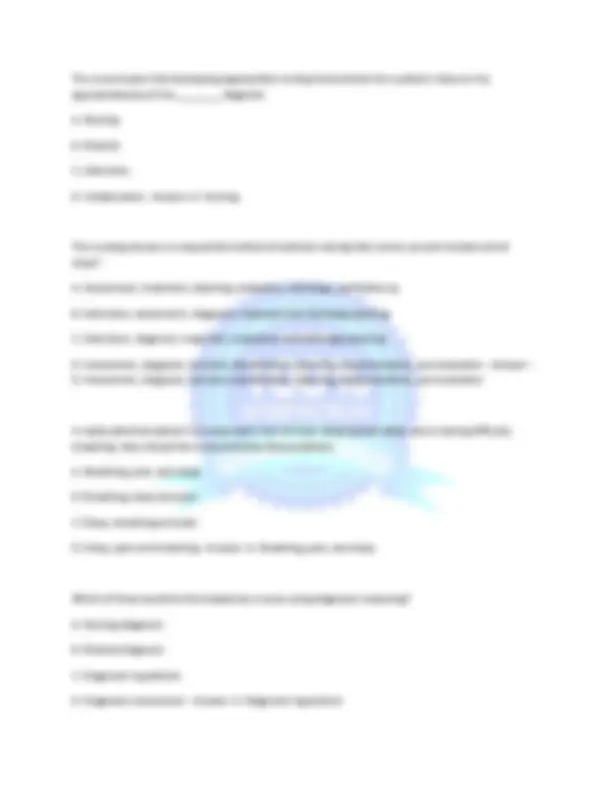
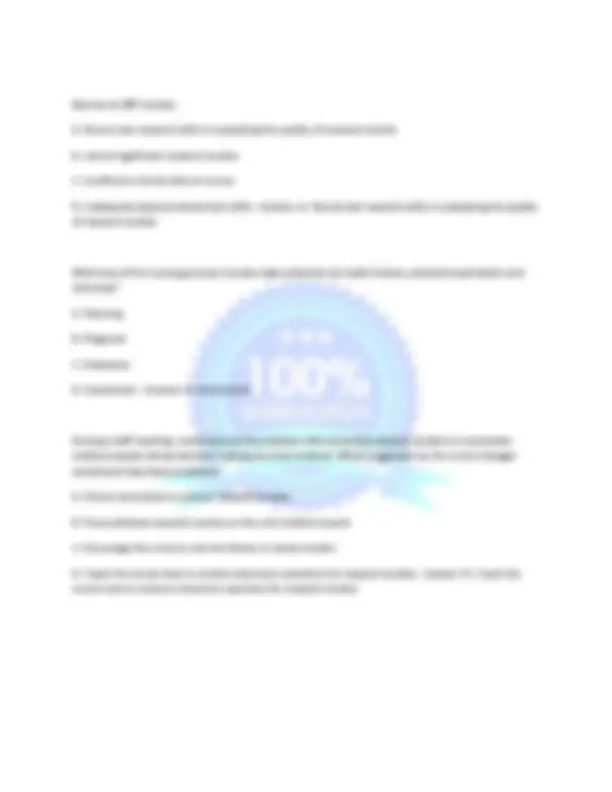
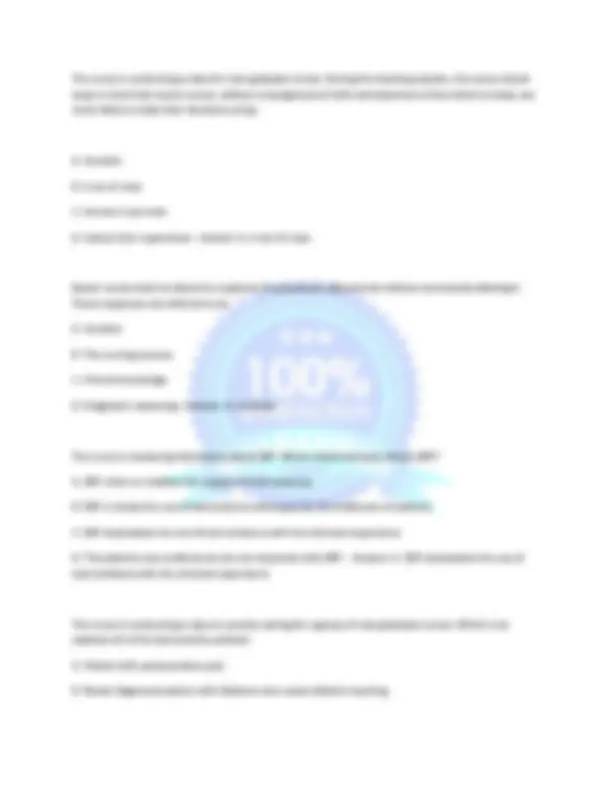
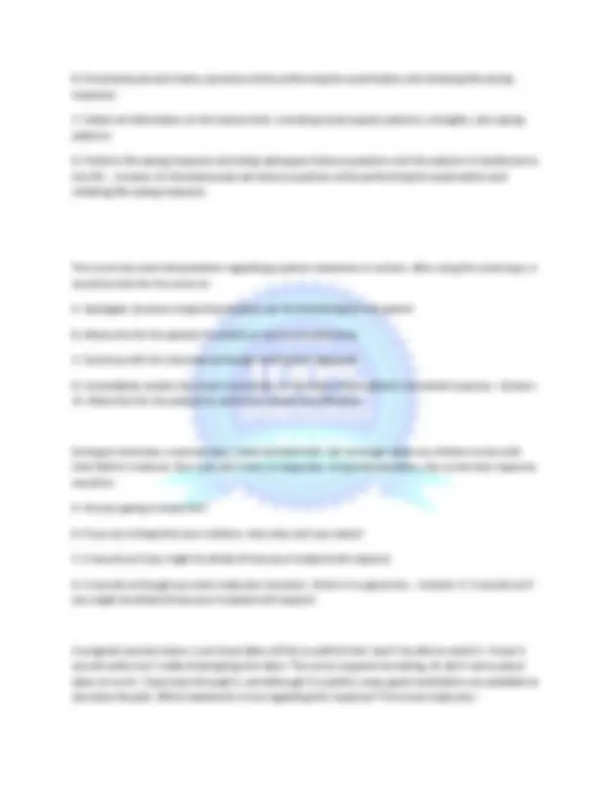
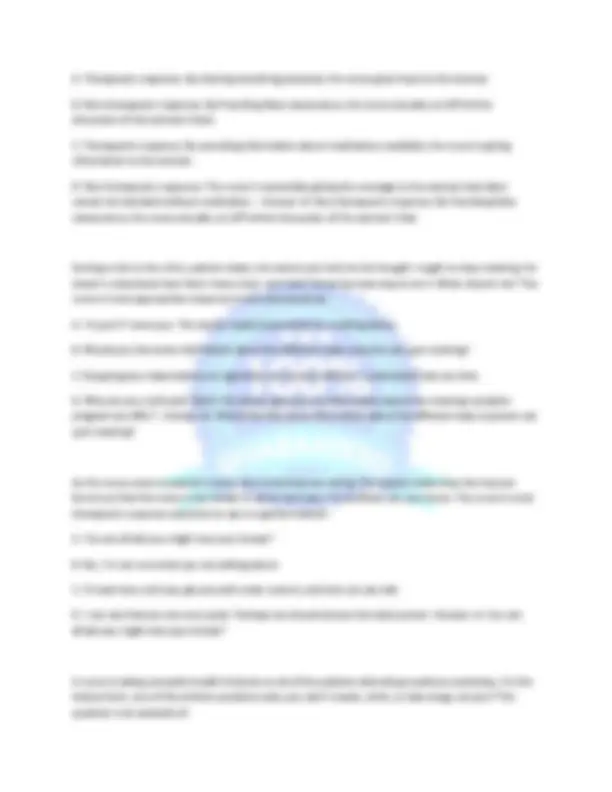
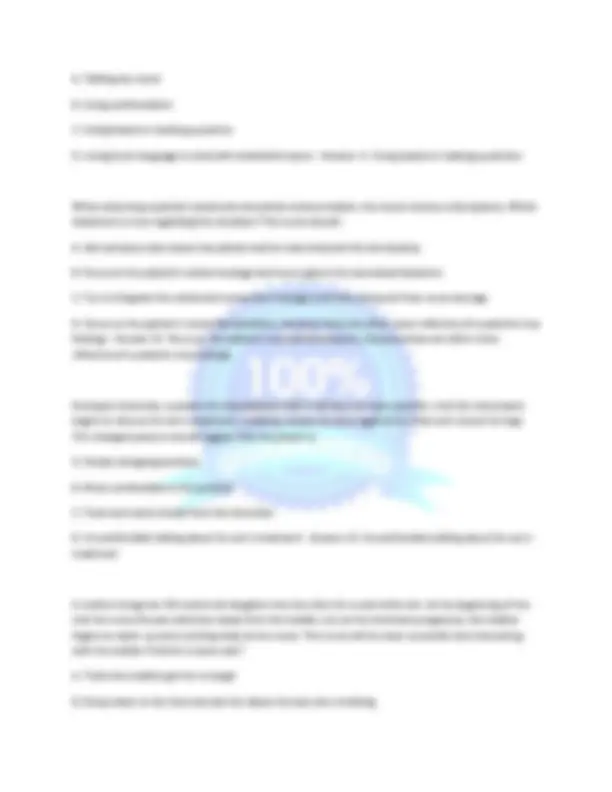
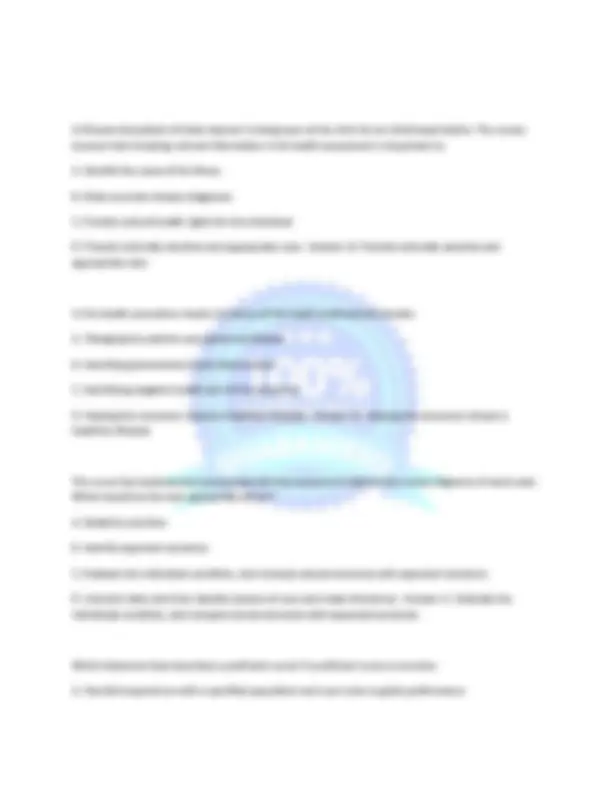
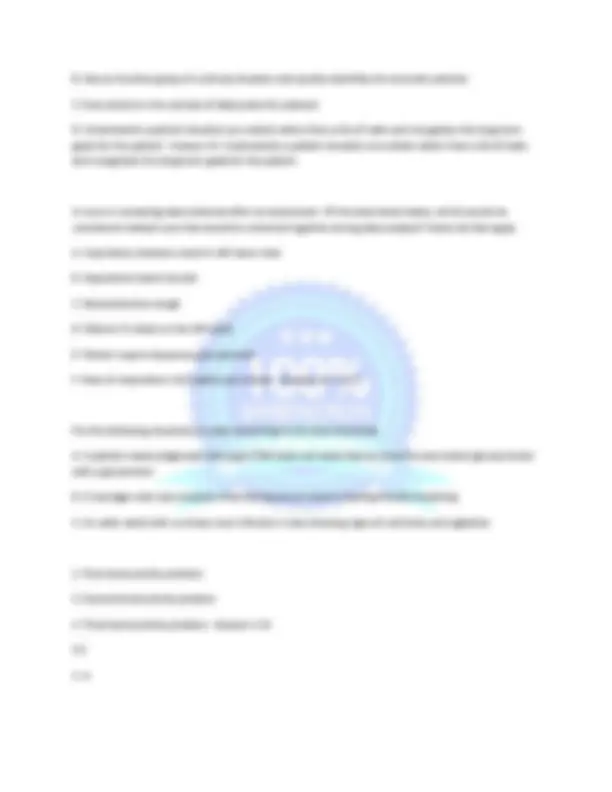
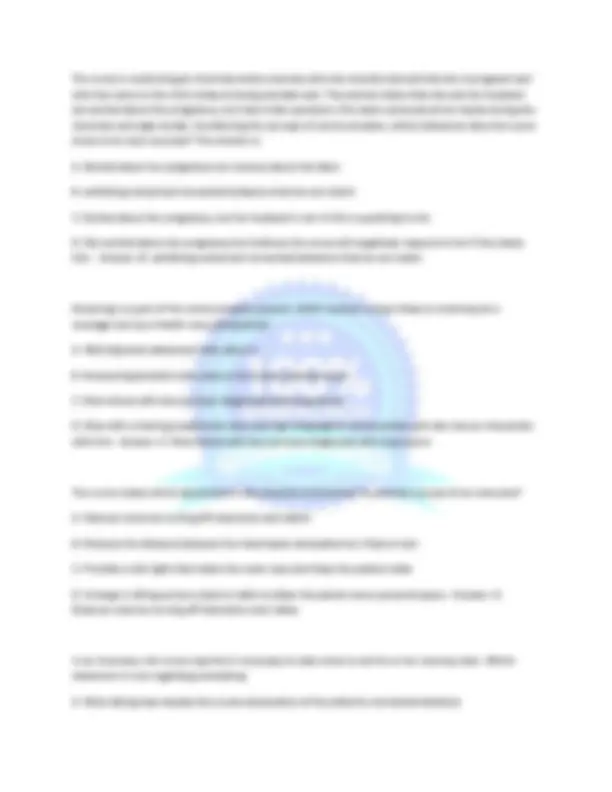
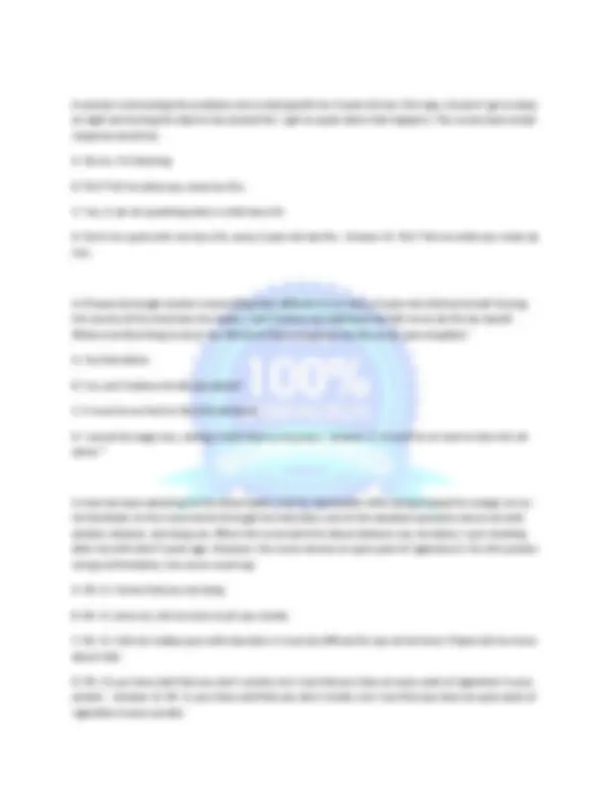
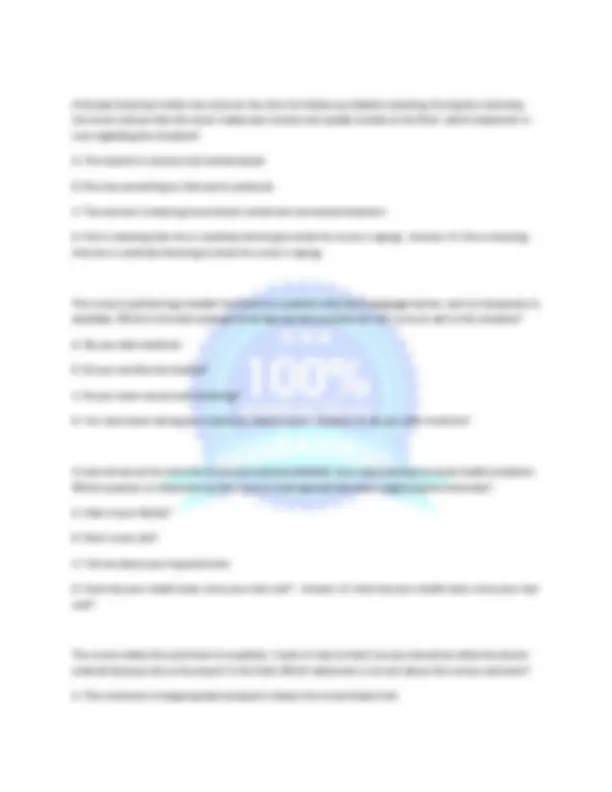
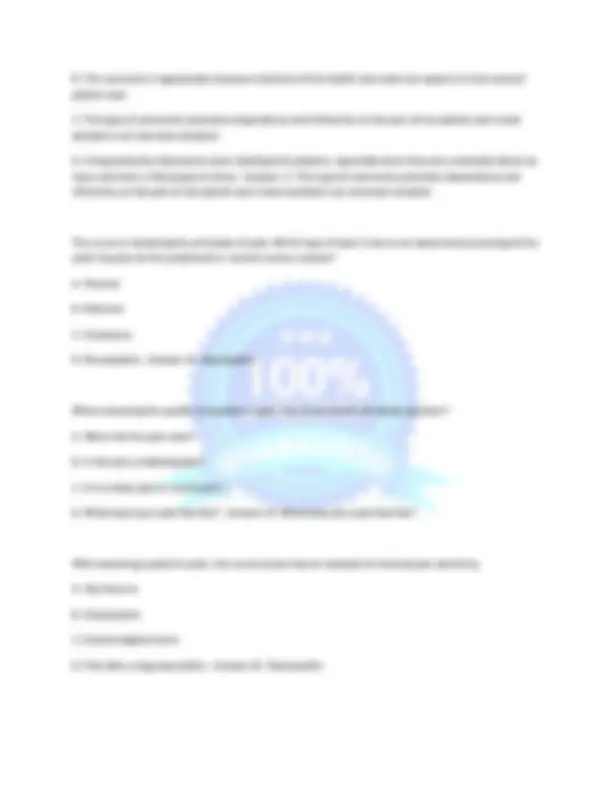
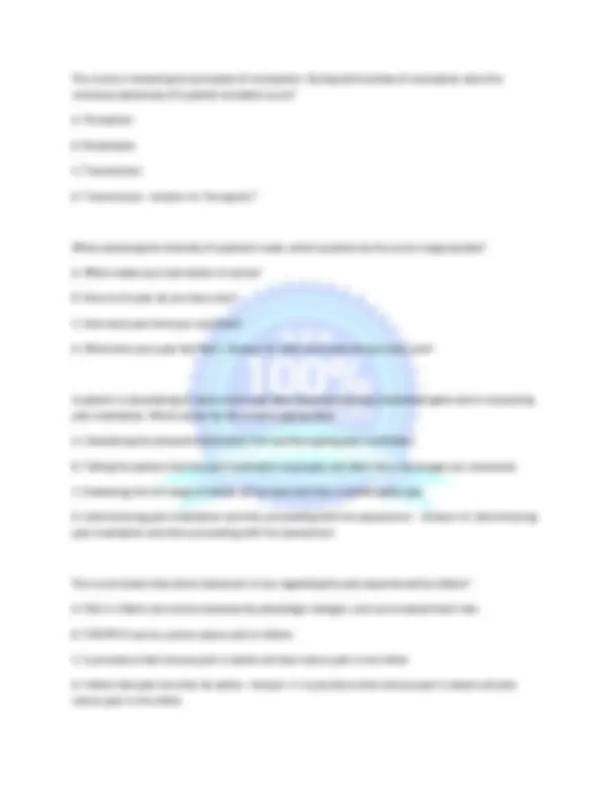
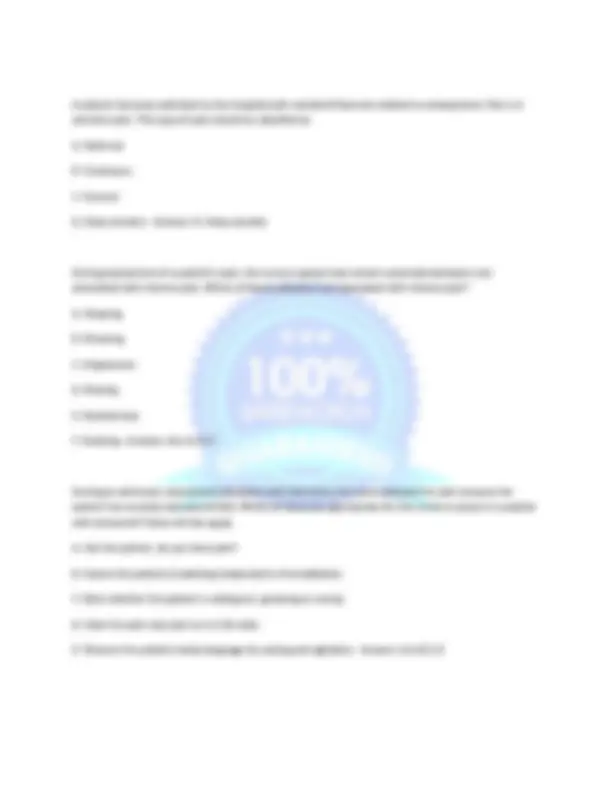

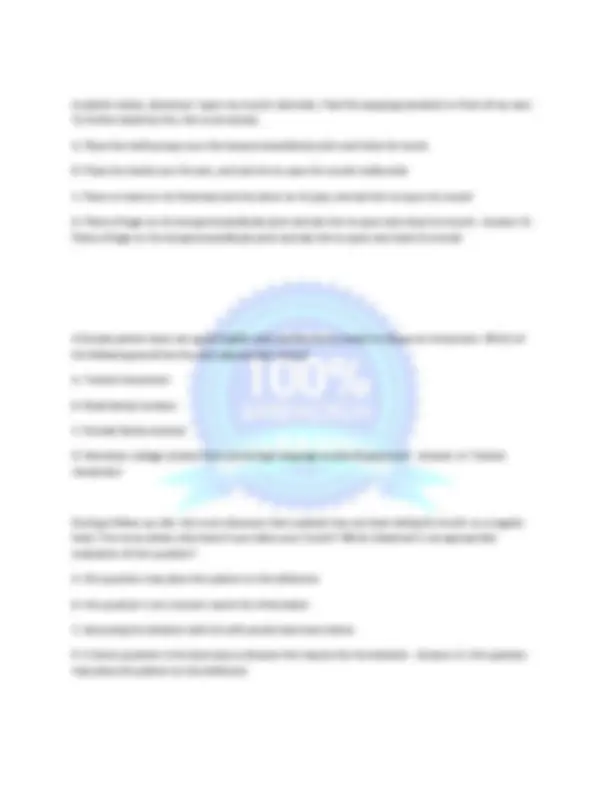
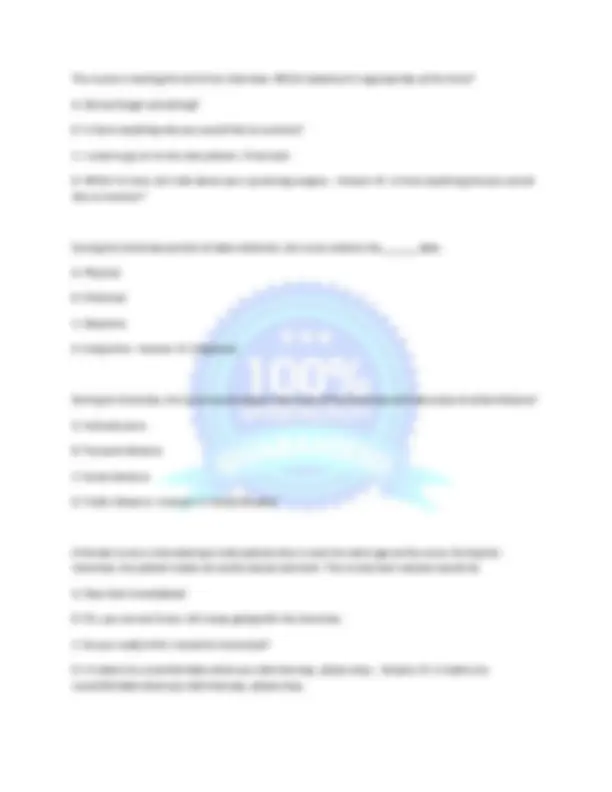
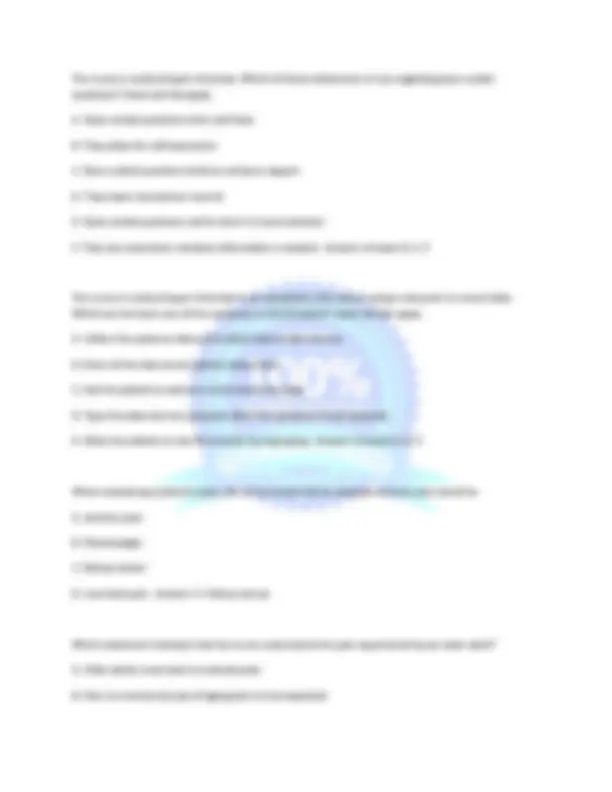
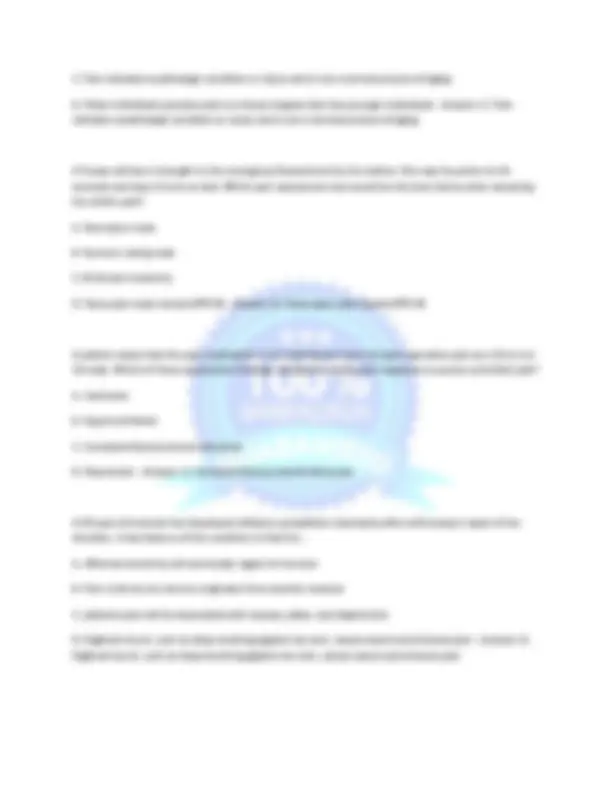
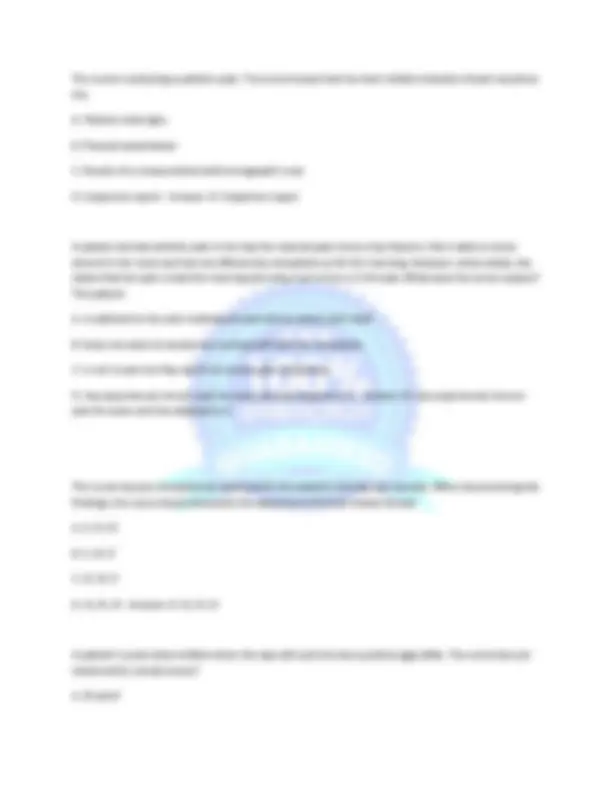
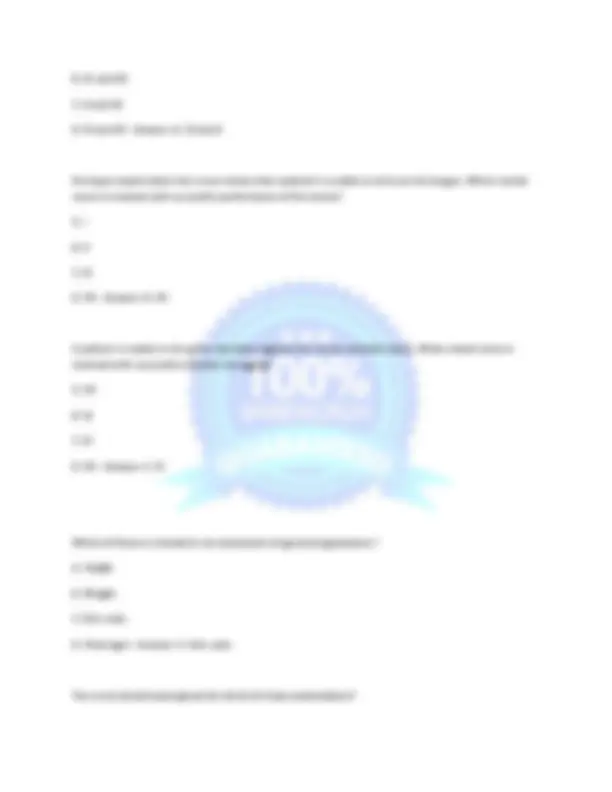
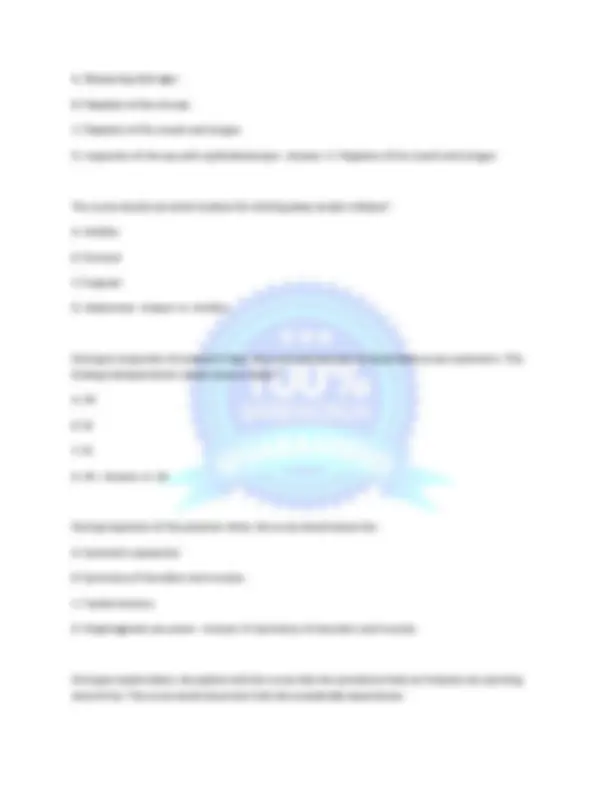
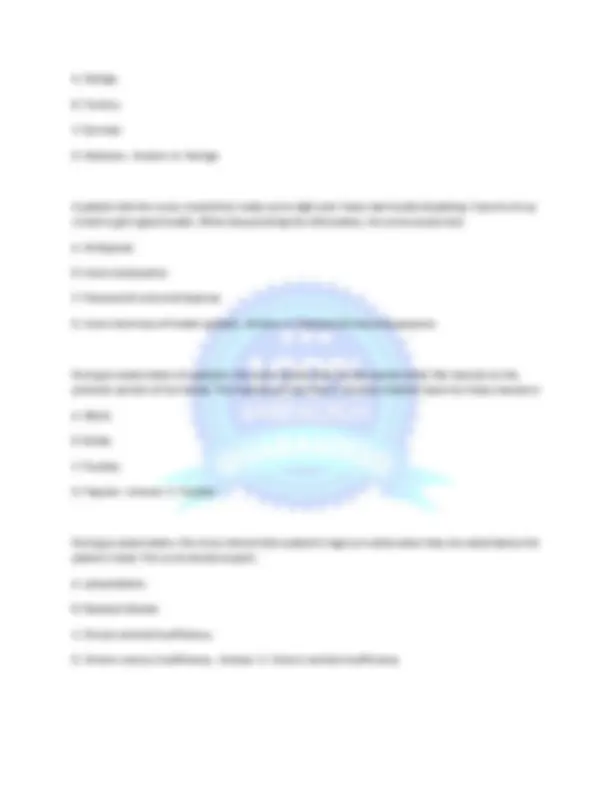
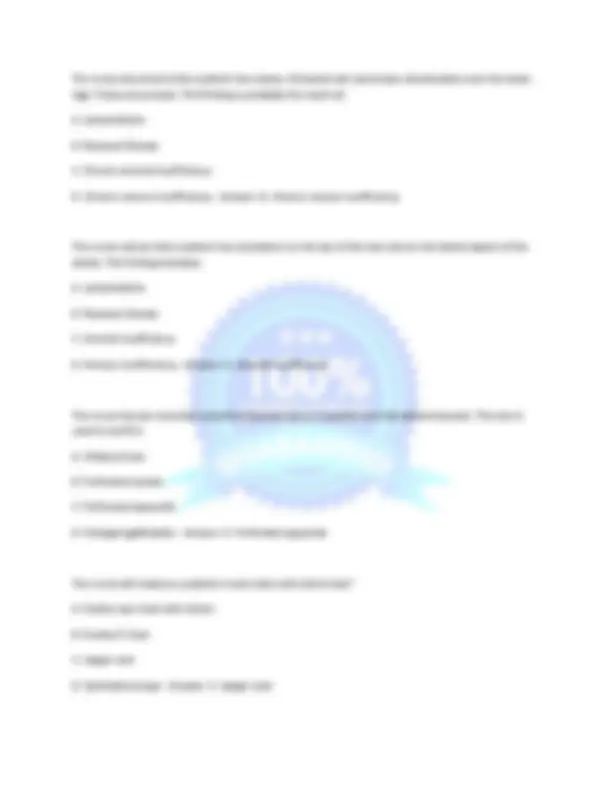
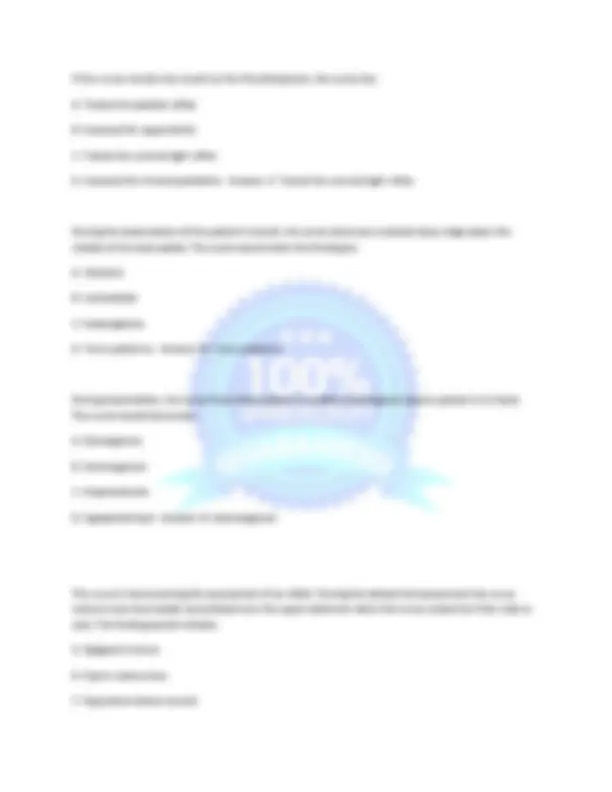
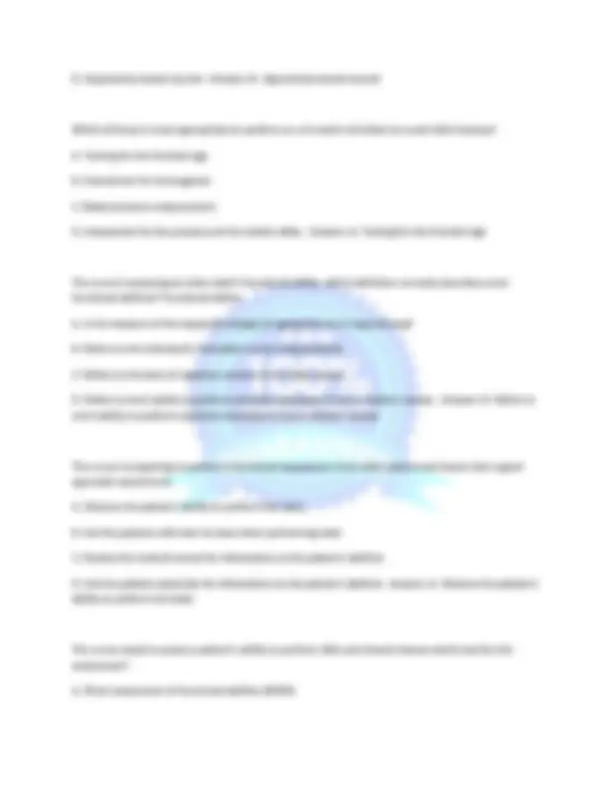
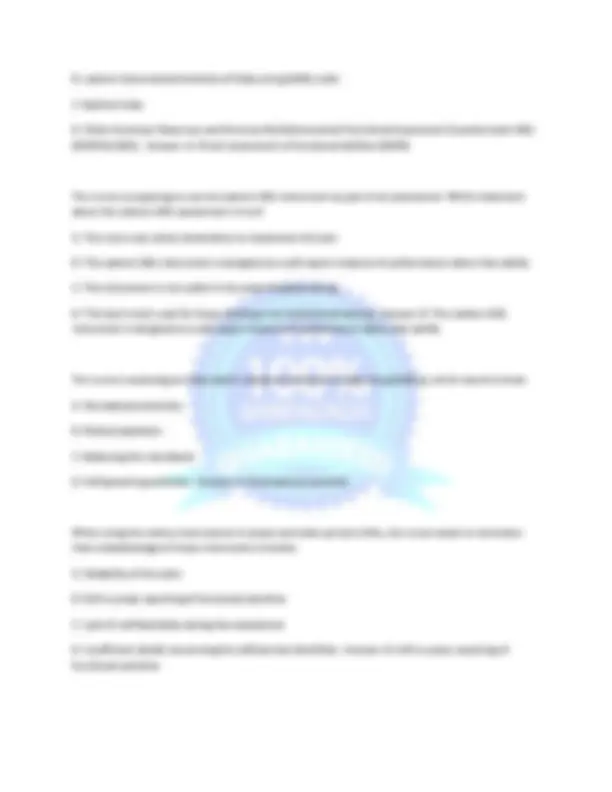
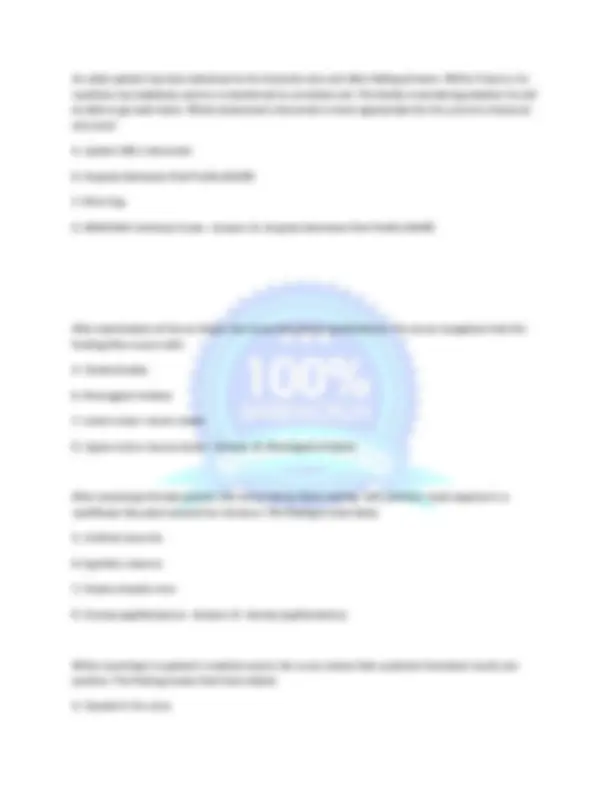
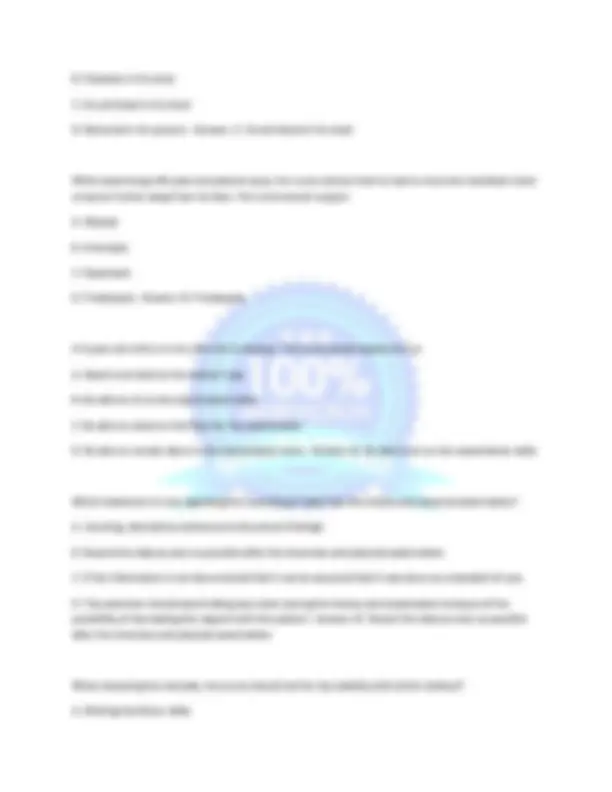
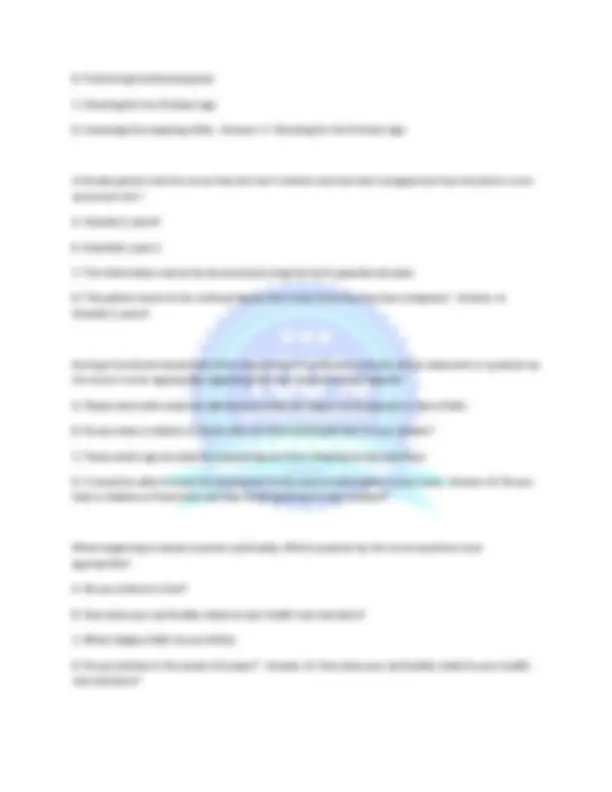
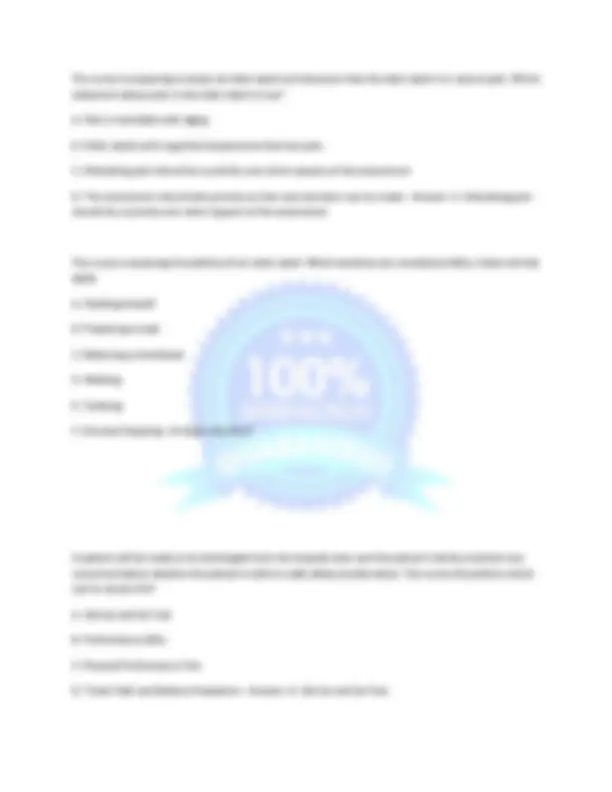
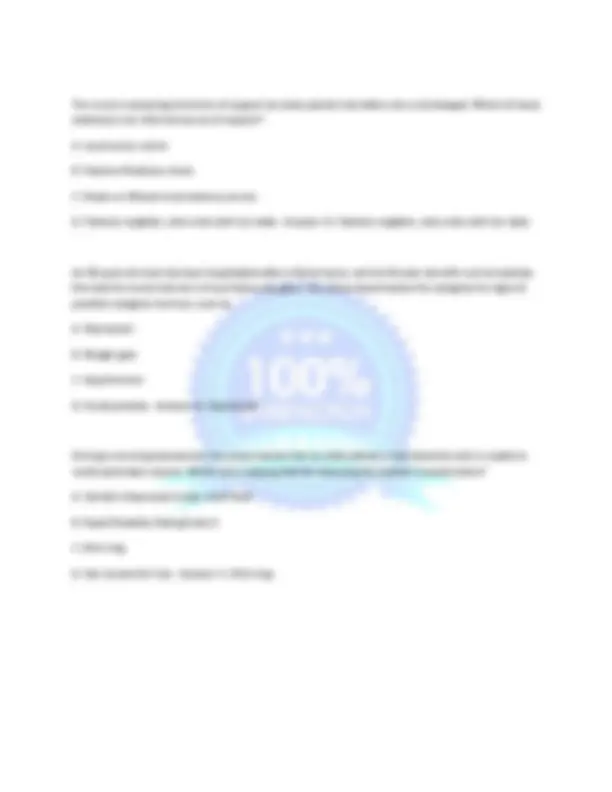


Study with the several resources on Docsity

Earn points by helping other students or get them with a premium plan


Prepare for your exams
Study with the several resources on Docsity

Earn points to download
Earn points by helping other students or get them with a premium plan
Community
Ask the community for help and clear up your study doubts
Discover the best universities in your country according to Docsity users
Free resources
Download our free guides on studying techniques, anxiety management strategies, and thesis advice from Docsity tutors
A series of multiple-choice questions related to the nursing process, assessment techniques, and evidence-based practice (ebp) in nursing. It covers topics such as objective and subjective data, prioritizing patient problems, diagnostic reasoning, and the application of research in clinical decision-making. The questions are designed to test the knowledge and critical thinking skills of nursing students and new graduate nurses, providing a comprehensive review of essential concepts in nursing practice. It also addresses holistic health and different types of nursing databases. Useful for nursing students preparing for quizzes or exams. (415 characters)
Typology: Exams
1 / 40

This page cannot be seen from the preview
Don't miss anything!

































After completing an initial assessment of a patient, the nurse has charted that his respirations are eupneic and his pulse is 58 beats per minute. These types of data would be.
A. Objective
B. Reflective
C. Subjective
D. Introspective - Answer--A. Objective
A patient tells the nurse that he is very nervous, is nauseated and feels hot. These types of data would be
A. Objective
B. Reflective
C. Subjective
D. Introspective - Answer--C. Subjective
The patients record, laboratory studies, objective data, and subjective data combine to form the
A. Data base
B. Admitting data
C. Financial Statement
D. Discharge Summary - Answer--A. Data base
When listening to a patients breath sounds, the nurse is unsure of a sound that is heard. The nurses next action should be to
A. Immediately notify the patients physician
B. Document the sound exactly as it was heard.
C. Validate the data by asking a coworker to listen to breath sounds
D. Assess it again in 20 minutes to note whether the sound is still present - Answer--C. Validate the data by asking a coworker to listen to breath sounds
When considering priority settings of problems, the nurse keeps in mind that second-level priority problems include which of these aspects?
A. Low self-esteem
B. Lack of knowledge
C. Abnormal laboratory values
D. Severely abnormal vital signs - Answer--C. Abnormal laboratory values
Which critical thinking skill helps see relationships among the data?
A. Validation
B. Clustering related cues
C. Identifying gaps in data
D. Distinguishing relevant from irrelevant - Answer--B. Clustering related cues
Barriers to EBP include:
A. Nurses lack research skills in evaluating the quality of research studies
B. Lack of significant research studies
C. Insufficient clinical skills of nurses
D. Inadequate physical assessment skills - Answer--A. Nurses lack research skills in evaluating the quality of research studies
What step of the nursing process includes data collection by health history, physical examination and interview?
A. Planning
B. Diagnosis
C. Evaluation
D. Assessment - Answer--D. Assessment
During a staff meeting, nurses discuss the problems with accessing research studies to incorporate evidence-based clinical decision making into their practice. Which suggestion by the nurse manager would best help these problems?
A. Forma committee to conduct research studies
B. Post published research studies on the units bulletin boards
C. Encourage the nurse to visit the library to review studies
D. Teach the nurses how to conduct electronic searchers for research studies - Answer--D. Teach the nurses how to conduct electronic searchers for research studies
The nurse is conducting a class for new graduate nurses. During the teaching session, the nurse should keep in mind that novice nurses, without a background of skills and experience from which to draw, are more likely to make their decisions using:
A. Intuition
B. A set of rules
C. Articles in journals
D. Advice from supervisors - Answer--b. A set of rules.
Expert nurses learn to attend to a pattern of assessment data and act without consciously labeling it. These responses are referred to as:
A. Intuition
B. The nursing process
C. Clinical knowledge
D. Diagnostic reasoning - Answer--A. Intuition
The nurse is reviewing information about EBP. Which statement best reflects EBP?
A. EBP relies on tradition for support of best practices
B. EBP is simply the use of best practice techniques for the treatment of patients
C. EBP emphasizes the use of best evidence with the clinicians experience
D. The patients own preferences are not important with EBP. - Answer--C. EBP emphasizes the use of best evidence with the clinicians experience
The nurse is conducting a class on priority setting for a group of new graduate nurses. Which is an example of a first-level priority problem
A. Patient with postoperative pain
B. Newly diagnosed patient with diabetes who needs diabetic teaching
A. A follow-up data base to evaluate changes at appropriate intervals
B. An episodic data base because of the continuing, complex medical problems of this patient
C. A complete health data base because of the nurses primary responsibility for monitoring the patients health
D. An emergency data base because of the need to collect information and make accurate diagnoses rapidly - Answer--C. A complete health data base because of the nurses primary responsibility for monitoring the patients health
Which situation is most appropriate during which the nurse performs a focused or problem-centered history?
A. Patient is admitted to a long-term care facility
B. Patient has a sudden and severe shortness of breath
C. Patient is admitted to the hospital for surgery the following day
D. Patient in an outpatient clinic has cold and influenza-like symptoms - Answer--D. Patient in an outpatient clinic has cold and influenza-like symptoms
A patient is in the clinic to have her blood pressure checked. She has been coming to the clinic weekly since she changed medications 2 months ago. The nurse should:
A. Collect a follow-up data base and then check her blood pressure
B. Ask her to read her health record and indicate any changes since her last visit
C. Check only her blood pressure because her complete health history was documented 2 months ago
D. Obtain a complete health history before checking her blood pressure because much of her history information may have changed - Answer--A. Collect a follow-up data base and then check her blood pressure
A patient is brought by ambulance to the ED with multiple traumas received in an automobile accident. He is alert and cooperative, but his injuries are quite severe. How would the nurse proceed with data collection?
A. Collect history information first, then perform a physical examination and institute life-saving measures
B. Simultaneously ask history questions while performing the examination and initiating life-saving measures
C. Collect all information on the history form, including social support patterns, strengths, and coping patterns
D. Perform life-saving measures and delay asking any history questions until the patient is transferred to the ICU. - Answer--B. Simultaneously ask history questions while performing the examination and initiating life-saving measures
The nurse has used interpretation regarding a patient statement or actions. after using this technique, it would be best for the nurse to:
A. Apologize, because using interpretation can be demeaning for the patient
B. Allow time for the patient to confirm or correct the inference
C. Continue with the interview as though nothing has happened
D. Immediately restate the nurse's conclusion on the basis of the patients nonverbal response - Answer- -B. Allow time for the patient to confirm or correct the inference
During an interview, a woman says, I have decided that I can no longer allow my children to live with their father's violence. But I just can't seem to leave him. Using interpretation, the nurses best response would be
A. Are you going to leave him?
B. If you are a frayed for your children, then why can't you leave?
C. It sounds as if you might be afraid of how your husband will respond.
D. It sounds as though you have made your decision. I think it is a good one. - Answer--C. It sounds as if you might be afraid of how your husband will respond.
A pregnant woman states, I just know labor will be so painful that I won't be able to stand it. I know it sounds awful, but I really dread going into labor. The nurse responds by stating, oh don't worry about labor so much. I have been through it, and although it is painful, many good medications are available to decrease the pain. Which statement is true regarding this response? The nurses reply was :
A. Talking too much
B. Using confrontation
C. Using biased or leading questions
D. Using blunt language to deal with distasteful topics - Answer--C. Using biased or leading questions
When observing a patient verbal and nonverbal communication, the nurse notices a discrepancy. Which statement is true regarding this situation? The nurse should :
A. Ask someone who knows the patient well to help interpret this discrepancy
B. Focus on the patient's verbal message and try to ignore the nonverbal behaviors
C. Try to integrate the verbal and nonverbal messages and then interpret them as an average
D. Focus on the patient's nonverbal behaviors, because these are often more reflective of a patients true feelings - Answer--D. Focus on the patient's nonverbal behaviors, because these are often more reflective of a patients true feelings
During an interview, a parent of a hospitalised child is sitting in an open position. And the interviewer begins to discuss his son's treatment, suddenly crosses his arms against his chest and crosses his legs. This changed posture would suggest that the parent is:
A. Simply changing positions
B. More comfortable in this position
C. Tired and need a break from the interview.
D. Uncomfortable talking about his son's treatment - Answer--D. Uncomfortable talking about his son's treatment
A mother brings her 28-month-old daughter into the clinic for a well child visit. At the beginning of the visit the nurse focuses attention away from the toddler, but as the interview progresses, the toddler begins to warm up and a smiling shyly at the nurse. The nurse will be most successful and interacting with the toddler if which is done next?
A. Tickle the toddler get her to laugh
B. Stoop down to her level and ask her about the toys she is holding.
C. Continue to ignore her until it is time for the physical examination
D. Ask the mother to leave during the examination of the toddler, because toddlers often fuss less if their parent is not in view - Answer--B. Stoop down to her level and ask her about the toys she is holding.
During an examination of a 3 year old child, the nurse will need to take her blood pressure. What might think nurse do to try to gain the child's full cooperation?
A. Tell the child that the blood pressure cuff is going to give her arm a big hug
B. Tell the child that the blood pressure cuff is asleep and cannot wake up
C. Give the blood pressure cuff a name and refer to it by this name during the assessment
D. Tell the child that by using the blood pressure cuff we can see how strong her muscles are. - Answer-- D. Tell the child that by using the blood pressure cuff we can see how strong her muscles are.
A 16 year old boy has just been admitted to the unit for overnight observation after being in an automobile accident. What is the nurses best approach to communicating with him?
A. use periods of silence to communicate respect
B. Be totally honest with him even if the information is unpleasant
C. Tell him that everything that is discussed will be kept totally confidential
D. Use slang language when possible to help him open up - Answer--B. Be totally honest with him even if the information is unpleasant *
A 75-year-old woman is at the office for a pre-op interview. The nurse is aware that the interview may take longer then interviews with younger persons. What is the reason for this?
A. An aged person has a longer story to tell
B. An aged person is usually lonely and likes to have someone with whom to talk
C. Aged persons lose much of their mental abilities and require longer time to complete an interview
D. As a person ages he or she is unable to hear, best the interviewer usually means to repeat much of what is said - Answer--A. An aged person has a longer story to tell
A 42-year-old patient of Asian descent is being seen at the clinic for an initial examination. The nurses knowns that including cultural information in his health assessment is important to:
A. Identify the cause of his illness
B. Make accurate disease diagnoses
C. Provide cultural health rights for the individual
D. Provide culturally sensitive and appropriate care - Answer--D. Provide culturally sensitive and appropriate care
In the health promotion model, the focus of the health professional includes:
A. Changing the patients perceptions of disease
B. Identifying biomedical model interventions
C. Identifying negative health acts of the consumer
D. Helping the consumer choose a healthier lifestyle - Answer--D. Helping the consumer choose a healthier lifestyle
The nurse has implemented several planned interventions to address the nurses diagnosis of acute pain. Which would be the next appropriate action?
A. Establish priorities
B. Identify expected outcomes
C. Evaluate the individuals condition, and compare actual outcomes with expected outcomes
D. Interpret data, and then identify clusters of cues and make inferences - Answer--C. Evaluate the individuals condition, and compare actual outcomes with expected outcomes
Which statement best describes a proficient nurse? A proficient nurse is one who:
A. Has little experience with a specified population and uses rules to guide performance
B. Has an intuitive grasp of a clinical situation and quickly identifies the accurate solution
C. Sees actions in the context of daily plans for patients
D. Understands a patient situation as a whole rather than a list of tasks and recognizes the long-term goals for the patient - Answer--D. Understands a patient situation as a whole rather than a list of tasks and recognizes the long-term goals for the patient
A nurse is reviewing data collected after an assessment. Of the data listed below, which would be considered related cues that would be clustered together during data analysis? Select all that apply
A. Inspiratory wheezes noted in left lower lobe
B. Hypoactive bowel sounds
C. Nonproductive cough
D. Edema +2 noted on the left hand
E. Patient reports dyspnea upon exertion
F. Rate of respirations 16 breaths per minute - Answer--A, C, E, F
Put the following situations in order according to the level of priority
A. A patient newly diagnosed with type 2 DM does not know how to check his own blood glucose levels with a glucometer
B. A teenager who was stung by a bee during soccer match is having trouble breathing
C. An older adult with a urinary tract infection is also showing signs of confusion and agitation
2.C
B. Note taking allows the patient to continue at his or her own pace as the nurse records what is said
C. Note taking allows the nurse to shift attention away from the patient resulting in an increased comfort level
D. Note taking allows a nurse to break eye contact with the patient which may increase his or her level of comfort - Answer--A. Note taking may impede the nurses observation of the patients nonverbal behaviors
The nurse asks, I would like to ask you some questions about your health and your usual daily activities so that we can better plan your stay here. This question is found at the ______ Phase of the interview process.
A. Summary
B. Closing
C. Body
D. Opening or introduction - Answer--D. Opening or introduction
A woman has entered the emergency Department after being battered by her husband. the nurse needs to get some information from her to begin treatment. what is the best choice for an opening phase of the interview with this patient?
A. Hello, Nancy, my name is Mrs. C
B. Hello, Mrs. H, my name is Mrs. C. It sure is cold today!
C. Mrs. H, my name is Mrs. C. How are you?
D. Mrs. H, my name is Mrs. C. I'll need to ask you a few questions about what happened - Answer--D. Mrs. H, my name is Mrs. C. I'll need to ask you a few questions about what happened
During an interview, the nurse states, you have mentioned having shortness of breath. Tell me more about that. Which verbal skill is used with this statement?
A. Reflection
B. Facilitation
C. Direct question
D. Open ended question - Answer--D. Open ended question
A patient has finished giving the nurse information about the reason he is seeking care. When reviewing the data, the nurse finds that some of the information about past hospitalizations is missing. At this point, which statement by the nurse would be most appropriate together these data?
A. Mr. Y, at your age, surely you have been hospitalized before!
B. Mr. Y, I just need permission to get your medical records from County medical
C. Mr. Y you mentioned that you have been hospitalized on several occasions. would you tell me more about that?
D. Mr. Y, I just need to get some additional information about your past hospitalizations when was the last time you were admitted for chest pain - Answer--D. Mr. Y, I just need to get some additional information about your past hospitalizations when was the last time you were admitted for chest pain
In using verbal responses to assist the patient's narrative, some responses focus on the patients frame of reference and some focus on the health care providers perspective. An example of a verbal response that focuses on the health care providers perspective would be:
A. Empathy
B. Reflection
C. Facilitation
D. Confrontation - Answer--D. Confrontation
When taking a history from a newly admitted patient, the nurse notices that he often pauses and expectantly looks at the nurse. What would be the nurse's best response to this behavior?
A. Be silent, and allow him to continue when he is ready
B. Smile at him and say, don't worry about all of this. I'm sure we can find out why you are having these pains.
C. Lean back in the chair and ask, you are looking at me kinda funny; There isn't anything wrong, is there?
D. Stand up and say, I can see this interview is uncomfortable for you. We can continue it another time. - Answer--A. Be silent, and allow him to continue when he is ready*
A female American Indian has come to the clinic for follow up diabetic teaching. During the interview, the nurse notices that she never makes eye contact and speaks mostly to the floor. which statement is true regarding the situation?
A. The woman is nervous and embarrassed
B. She has something to hide and is ashamed
C. The woman is showing inconsistent verbal and nonverbal behaviors
D. She is showing that she is carefully listening to what the nurse is saying - Answer--D. She is showing that she is carefully listening to what the nurse is saying
The nurse is performing a health interview on a patient who has a language barrier, and no interpreter is available. Which is the best example of an appropriate question for the nurse to ask in this situation?
A. Do you take medicine
B. Do you sterilize the bottles?
C. Do you have nausea and vomiting?
D. You have been taking your medicine, haven't you? - Answer--A. do you take medicine?
A man arrives at the clinic for his annual wellness physical. He is experiencing no acute health problems. Which question or statement by the nurse is most appropriate when beginning the interview?
A. How is your family?
B. How is your job?
C. Tell me about your hypertension.
D. How has your health been since your last visit? - Answer--D. How has your health been since your last visit?
The nurse makes this comment to a patient, I know it may be hard, but you should do what the doctor ordered because she is the expert in this field. Which statement is correct about the nurses comment?
A. This comment is inappropriate because it shows the nurses blame him
B. This comment is appropriate because members of the health care team are experts in their area of patient care
C. This type of comments promotes dependency and inferiority on the part of the patient and is best avoided in an interview situation
D. Using authority statements when dealing with patients, especially when they are undecided about an issue comment is Necessary at times - Answer--C. This type of comments promotes dependency and inferiority on the part of the patient and is best avoided in an interview situation
The nurse is reviewing the principles of pain. Which type of pain is due to an abnormal processing of the paint impulse do the peripheral or central nervous system?
A. Visceral
B. Referred
C. Cutaneous
D. Neuropathic - Answer--D. Neuropathic
When assessing the quality of a patient's pain, the nurse should ask which question?
A. When did the pain start?
B. Is the pain a stabbing pain?
C. Is it a sharp pain or a dull pain?
D. What does your pain feel like? - Answer--D. What does your pain feel like?
With assessing a patient's pain, the nurse knows that an example of visceral pain would be;
A. Hip fracture
B. Cholecystitis
C. Second-degree burns
D. Pain after a leg amputation - Answer--B. Cholecystitis